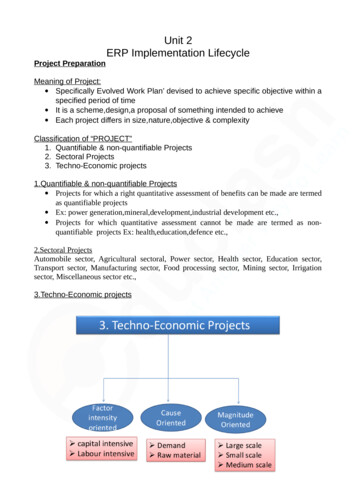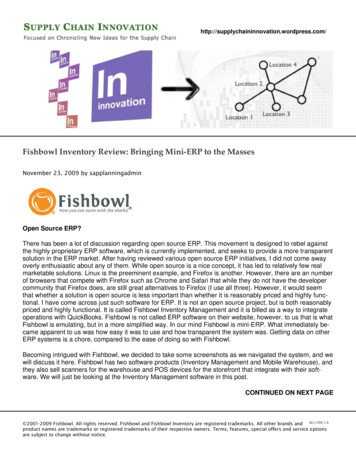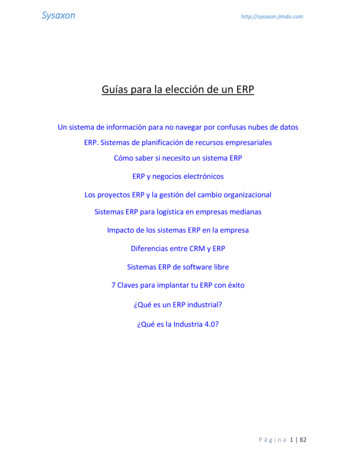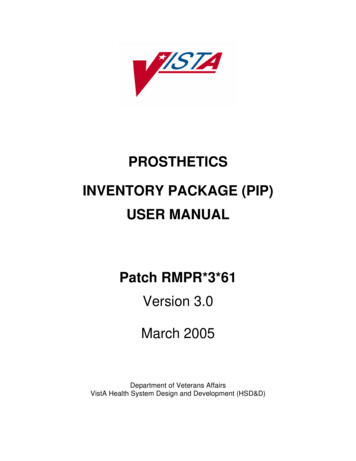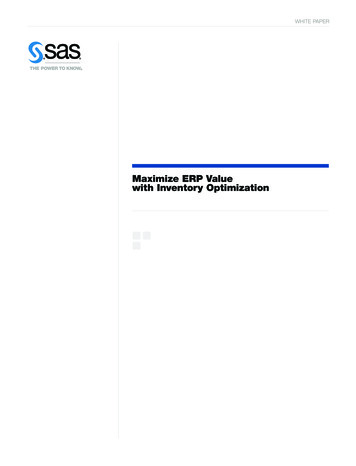
Transcription
WHITE PAPERMaximize ERP Valuewith Inventory Optimization
MAXIMIZE ERP VALUE WITH INVENTORY OPTIMIZATIONTable of ContentsPressures on ERP Systems in Supply Chain Planning .3De-Normalized Tables.4Sequential Optimization .5Upstream Service Levels.5Accumulated Demand Variance.7Multiple Hierarchies of Service-Level Requirements.8The Systematic Multi-Echelon InventoryOptimization Process.9Transactional Versus Systematic Multi-Echelon Inventory Optimization.11Demand and Supply Visibility.11Economic Order Quantity Shortcomings.11Demand Signal Delays.12Conclusion.13i
MAXIMIZE ERP VALUE WITH INVENTORY OPTIMIZATIONManufacturers and retailers have improved business operations through theimplementation of enterprise resource planning (ERP) and supply chain management(SCM) systems. On the whole, the ERP and SCM investments have been deemedsuccessful by virtue of the positive returns on investment they’ve created throughwide-ranging operational and capital management efficiencies. In many cases, thosesystems have been deployed for purposes other than their original intent, with manymanufacturers adapting them in creative ways for special business needs.However, the successes of ERP and SCM systems have not come without questionsand criticisms. Surveys and anecdotal evidence clearly show that C-level executivesare uneasy about the ROI of their ERP, manufacturing resource planning (MRP), SCMand other enterprise-level systems after more than 30 years of investments in them.They all talk about squeezing more value from these huge systems.1 In regard toSCM, typical ERP systems attempt to organize supply and demand signals with defacto sequential optimization – a process which leads to inflated demand forecastsand stock overages at numerous points in the supply and manufacturing chains.As worldwide economic activity increases and product demands shift, manufacturingorganizations will need to improve their performance in minimizing unacceptableinventory positions.In response, there is new emphasis on the need to work smarter using analytical andoptimization approaches to inventory and supply chain management. Customers’signals produce advance notice of demand and the systems should respond withnecessary adjustments that reduce and eliminate the bullwhip effect. But all too oftensenior managers are frustrated. Their ERP and SCM systems haven’t been ableto generate the more advanced, optimized results that they see as possible – andmuch needed – to reduce or eliminate inefficiencies and unbalanced inventoryand to focus on good management.Inventory Effects on FinishedGoods Manufacturers andRetailersThe effects of effective inventorymanagement – or mismanagement– can be wide-ranging. Trackinginventory is essential to running abusiness efficiently, and managinginventory effectively can have bigimpacts on profitability. Here are justtwo situations that occur: Customers often will not tolerateproduct unavailability or delays indelivery. In some cases, a shortagemay be a small inconvenience(such as an unavailable part atyour favorite hardware store),while in other cases it maycause a severe problem (such asinterrupting production-line activityat a computer manufacturer).On some occasions, sporadicshortages can be expected, butFinished goods manufacturers and retailers can use technology solutions foranalytics and optimization to set measurable and relevant improvement goals forthe enhancement of their ERP/SCM outcomes related to supply chain and inventory.For example, SAS solutions have been successful in: Reducing capital invested in inventory by a minimum of 15 percent. Maintaining high service levels while eliminating inventory imbalances. Reducing the effort, and improving the quality, of materials requisitionsmanagement.frequent shortages may ultimatelydamage a company’s reputation,customer loyalty and marketshare. Overabundant, slow-movinginventories can place a seriousstrain on a company’s availablecapital and inhibit the company’sability to take advantage offinancial opportunities. In order1Analyst surveys and trade journal articles abound concerning the issue of ROI and ERP. C-levelexecutives in general have an unsettled sense of enterprise systems not delivering what theyexpected, although, in fairness, few have had clear metrics to measure success and ROI.Here is a sampling of recent studies and e/magazine/read/view/The Circle of ERP Life 3871,http://www.automationworld.com/primers-8107, http://www.forrester.com/rb/teleconference/cios planeffectiveness reviews to squeeze ages/features/coverstory-feature-augsept.htmlto compete effectively in today’sbusiness world, it is imperativeto efficiently maintain adequateinventories.1
MAXIMIZE ERP VALUE WITH INVENTORY OPTIMIZATIONThis white paper examines why problems emerge when firms try to developan analytics and optimization mindset about their inventory and SCM practices.The paper will also show why running an inventory optimization solution with alreadyinstalled ERP/SCM systems can enable organizations to operate profitably withinnew market dynamics.Optimization Can Occur for All Finished GoodsManufacturers and RetailersThe limitations to ERP and SCM systems as they apply to finished goodsinventories are beginning to manifest in all the manufacturing industries. Thefollowing snapshots provide a view of each vertical’s primary delivery objectiveand the associated benefit that can be derived from analytics and optimization: Consumer Packaged Goods: Delivery Objective: Customer fulfillment is the ultimate goal of CPG supplychains. Improving fulfillment levels creates customer satisfaction andyields impressive financial improvements.Optimization Goal: At a constant cost to serve, reducing out-of-stocksincreases the top line, dropping most of the additional gross margin tothe bottom line. Electronics: Delivery Objective: Consumer electronics and mobile devices are likefashion items with short product life cycles that demand fast turnaround.Manufacturers must keep fresh assortments before customers, despite agrowing array of SKUs.Optimization Goal: Increased commoditization and customerexpectations of on-demand stock have driven turnaround times to as lowas 24 hours and created a need for readily available inventory and a morebalanced stocking strategy. Food & Beverage: Delivery Objective: Out-of-stocks equate to lost sales, requiring companiesto be sensitive to maintaining very high customer service-level goals.Optimization Goal: Operations departments can get caught betweensales departments that want outstanding service and production planningdepartments that control the inventory. Delivery optimization is critical. Health Care and Pharmaceuticals: 2Delivery Objective: Health care and pharmaceutical sector companiesare expected, or even required, to deliver very high customer servicelevels, even for slow-moving products. Product obsolescence must bemanaged, particularly for products with expiration constraints measuredin months or even days.Optimization Goal: Combining seasonal behavior and sell-by dates makesinventory planning even more challenging, but must be achieved.
MAXIMIZE ERP VALUE WITH INVENTORY OPTIMIZATION Industrial and Durables: Delivery Objective: Manufacturing these goods is particularly challengingwhen markets require smaller volumes that translate into large mixes andslower moving products whose demand is highly variable and harder topredict.Optimization Goal: When sales are made through wholesalers andretailers, a high service level is expected. Big customers move a lot ofproduct and want close integration with suppliers, even to the point ofrequiring inventory to be directly managed by suppliers (vendor-managedinventory, or VMI). Wholesale Distribution Delivery Objective: High customer service levels are critically importantto wholesale distributors, where an unserved order usually means a lostsale. Service-level shortfalls reduce the top line directly.Optimization Goal: Achieving outstanding service levels is difficult. Whenyou increase your inventories, costs increase and service levels respondslightly, if at all.Pressures on ERP Systems in Supply Chain PlanningFinished goods manufacturers and retailers know that efficient management of theirsupply chain can be a competitive differentiator, but they struggle with customers’ever-increasing demands on overtaxed transactional and operational systems.Industry executives increasingly acknowledge that moving from a push environment,where suppliers have relative control over their inventories, to today’s pullenvironment, where customers dictate inventory, adds extra volatility to their ERPand SCM systems.As a result, manufacturing companies are hedging their bets by acquiringand maintaining safety stocks to counteract the potential disruptive forces ofunanticipated customer demand. From an SCM systems perspective, companies areusing workarounds or special alert systems developed on an ad hoc, reactive basis.The companies have still failed to achieve an optimized, balanced and efficient statedue to the inherent structure of ERP systems that creates problems for those tryingto reduce safety stocks with analytics and optimization. What if ERP systems couldconduct their own advanced optimization activities?The following sections look at the challenges posed by de-normalized tables,sequential optimization, upstream service levels, accumulated demand variance andmultiple hierarchies of service-level requirements.3
MAXIMIZE ERP VALUE WITH INVENTORY OPTIMIZATIONDe-Normalized TablesThe transactional nature of ERP systems requires them to operate in near-real timeusing normalized tables – large tables that have been converted into a number ofsmaller tables to eliminate as much information redundancy as possible. The smalltables, called star schemas, are arranged so that the user can extract the informationneeded from other tables. Each table can quickly make the correct connections toother table combinations to retrieve necessary information. For instance, as the resultof star schemas extracting data from various tables, a call center agent who needssome, but not all, customer information would see the name, address, cellphonenumber, cellphone model and previous notes when responding to a technicalproblem.When the user needs online analytical processing (OLAP) de-normalization, data isextracted, transformed and loaded (ETL) from normalized tables into a format thatcan be analyzed (instead of simply being displayed). This array of table informationfor OLAP is called a snowflake schema and is designed to quickly pull data intousable OLAP cubes that can be viewed from several different perspectives. Forexample, OLAP data could be viewed as combinations of information over time;OLAP cubes are the basis for analytical review of transactional activities.De-normalized tables create problems when users attempt to perform higher-levelanalytics or optimization with them. Analytics and optimization require calculationsusing variables – lots of variables. While most normalized tables and schemasadhere to a three normal forms (3NF) design, the number of variables required foroptimization creates large numbers of de-normalized tables. The difficulty comesin arranging the de-normalized tables into logical snowflake patterns because infast-moving transactional systems, computing performance can erode quickly. Inresponse, ERP managers tend to create shortcuts to circumvent the problemscaused by variables. The concerns then become ones of confidence: whether theinformation has value, is deficient or is misleading because of some miscalculationor because of a misalignment of table data.The opportunities for miscalculated or misleading information are nearly infinite.Consider, for example, the complexity of a simple product like shampoo. Wheredid its raw materials come from? How many warehouses stored the materials?Where did the raw materials get combined, processed and manufactured?The complexity grows exponentially when considering the millions of productcombinations produced by consumer packaged goods, electronics, food andbeverages, health care products, pharmaceuticals and industrial and durable goodscompanies.Because of the enormity of the data requirements, high-powered analytics andoptimization processes normally run as a weekend batch job, to extract, transformand load data from disparate, diverse sources into an optimization run. The objectiveis to pull this information together so the system can attempt to understand thecomplex networks of inventory flow.4
MAXIMIZE ERP VALUE WITH INVENTORY OPTIMIZATIONERP systems have a limited ability to create de-normalized tables so that batchrun optimization can occur with high levels of confidence. Instead, the ERP systemwill tend to create “islands of efficiency,” where it views a location or node as asingle entity and then attempts to compile data specific for that location to produceprojected best practice rules for the item-location pairings.Sequential OptimizationThe next step in ERP processing of de-normalized tables is sequential optimization,where (as shown in Figure 1) the islands of efficiency links in the chain are optimized,and the system goes to the next link up the chain to continue optimization insequence. The ERP process is locked into this sequential optimization format; thereare few or no “arc” connections between the link locations, a limitation that reducesthe number of variables that can be used, essentially creating a de facto optimizationprocess of its own, with little flexibility or agility.Figure 1: Sequential optimization “islands of efficiency.”While sequentially optimized islands of efficiency do generate some benefits, theyalso will amplify demand variations and literally make supply variability invisible. Thisoccurs because they operate without knowledge of, visibility of or communicationwith the chain, making it nearly impossible to maintain optimized inventories. Thebullwhip effect then can throw everything else out of alignment when companies areattempting to use transactional ERP or SCM systems to develop optimized supplychain planning.The following sections examine these activities and why they create problems in atransactional ERP/SCM system.Upstream Service LevelsFigure 2 depicts how the ERP/SCM system tries to optimize the customer-facingstorefront (POS 1) with a 95 percent service level. Because the shortcut process inthe transactional system is to optimize the island of efficiency, it is not going to crossover any variables from the upstream location (WH 1). The system’s business ruleor assumption is to provide a 100 percent service level at WH 1 to the downstreamcustomer-facing location (POS 1).5
MAXIMIZE ERP VALUE WITH INVENTORY OPTIMIZATION For a sequentialapproach, theupstream servicelevel is always100%, assumingavailability is infinite. This is never thecase. Single-echelonsystems do not haveinputs for upstreamservice levels. Multi-echelonsystems allow inputsfor upstream servicelevels and take intoconsideration theuncertainty ofresources fromupstream.WH 1POS 1Service level 95%SequentialService level assumed 100%WH 1POS 1Service level 95%SystematicService level assumed 90%Figure 2: Sequential optimization assumes the upstream service level will always be 100percent, whereas systematic optimization recognizes that upstream service level varies.Because there is no assumed uncertainty in the supply of inventory, the downstreamPOS 1 has an artificially low safety stock position. The demand variable has beenfactored in, but the supply variable has been withdrawn from the equation, and thebuyer would become understandably panicked, possibly rushing stock from aninternal warehouse or outside vendor because of unforeseen supply issues. Thebuyer suffers the consequences of removing the supply variability factor from theinventory calculations.One immediately apparent remedy is to reduce the expected service level to 90or 95 percent. This would require the system to develop large numbers of denormalized tables to account for each service-level combination, adding enormouscomplexity to the transactional systems’ attempts to optimize the data.In these circumstances, most organizations will try to circumvent the problem byeither artificially increasing the safety stock on key items at customer locations ortrying to create an early-warning system for potential shortages and increasing stockat the upstream location. Both workarounds create additional inventory. In fact,the second workaround actually amplifies the next problem occurring in sequentialoptimization – accounting for accumulated demand variance.6
MAXIMIZE ERP VALUE WITH INVENTORY OPTIMIZATIONAccumulated Demand VarianceAccumulated demand variances create the need for additional shortcuts and havethe effect of producing more inefficiency. Figure 3 depicts customer-facing locationshaving service-level requirements based on the upstream location always havingstock and each of the POC nodes having a 95 percent service level based on ademand projection with a built-in demand variance. Islands of efficiencies exist inevery downstream location because each passed on its accumulated demandvariances back to WH 1. This dramatically increases the inventory in WH 1 toovercome the assumed 100 percent service level required and prompts the firstwave of the bullwhip effect. Since it is sequential,WH 1 has no visibilityof the demandpatterns of POS 1,assumes the patternto be 200 everytwo weeks. Problem compoundedwith introduction ofPOS 2. Multi-echelon systemaccounts for demandpatterns downstream. Takes into account“skuloc” ID. Treats POS 2 asunique with its ownservice level.WH 1POS 1Service level 95%Sale of 100 every weekOrder of 200every 2 weeksPOS 2Service level 95%SequentialService level assumed 100%WH 1POS 1Service level 95%POS 2Service level 95%Service level 90%SystematicFigure 3: The accumulated demand variance is pushed upstream with sequentialoptimization, but systematic optimization treats each downstream location as aseparate, non-aggregated demand signal.When distance and time increase from the initial demand signal, the systemsproduce notifications that more accumulated inventory is needed to offset the“demand amplification.” Termed “redundant inventory,” this escalating stock-up isin reaction to the accumulated demand variance repeated over and over. Upstreamparts suppliers in the automotive industry have been rendered insolvent when theywere stuck with massive, obsolete inventories due to the bullwhip effect.7
MAXIMIZE ERP VALUE WITH INVENTORY OPTIMIZATIONMultiple Hierarchies of Service-Level RequirementsWhen ERP systems see accumulated demand working its way up the chain, it viewsthat demand as an aggregated total and does not provide any additional insights intothe different service-level requirements necessary to meet that demand, either bysite or by SKU. This causes the organization to protect itself with even more safetystock add-ons than it would in the previous two examples of demand variance andassumed upstream service levels.The usual workaround for adjusting inventories to accumulated demand is theinstallation of simple ABC classifications. However, the ERP system struggles withmillions upon millions of product and location pairings in a complex supply chain.Whether it’s a downtime service-level agreement with huge penalties, or ensuringthat enough cases of cola are at a featured event in a company’s mountain andbeach stores, incorrect service levels will create problems. The second part of theworkaround is to assign review time with alerts for analysts to examine the “A” itemsthat are beyond established tolerances. Downstream isaggregated to onedemand. No concept of POS 1and POS 2. Hence only oneservice level.WH 1POS 1Service level 95%Sale of 100 every weekOrder of 200every 2 weeksPOS 2Service level 95%SequentialService level assumed 100% Each site is unique,hence carries its ownservice level.WH 1POS 1Service level 95%POS 2Service level 90%Service level 90%Figure 4: Sequential optimization cannot recognize different service levels, butsystematic optimization allows for downstream location-product combinations to haveunique service-level requirements.8Systematic
MAXIMIZE ERP VALUE WITH INVENTORY OPTIMIZATIONThe Systematic Multi-Echelon InventoryOptimization ProcessOut of One Loss Category,into AnotherAs discussed, single service-levelinventory management createsproblems for large manufacturersthrough no fault of their own inseeking various remedies. Oneleading consumer goods company-attempted working with its vendormanaged inventory (VMI) systemFigure 5: Systematic optimization overcomes the shortcomings of sequentialoptimization to create a supply chain that runs in harmony.To summarize, the ERP shortcomings – de-normalized tables, de facto sequentialoptimization, accounting for accumulated demand variance and multiple hierarchiesof service-level requirements – challenge the ability of transaction-oriented ERPsystems to perform analytics and optimization in the supply chain. While singleechelon islands of efficiency can produce some benefits with supply chain planning,it is usually due to reporting and increased visibility into outlier problems. There stillremains the problem of sequential optimization when the nodes or links in the chainare not connected systematically.to categorize all products and loadall its important customers into amassive Excel spreadsheet, thenupdated the results on a monthlybasis. The results allowed it toassign service levels to the majorcustomers, major products and thecollective advertising budgets. Fromthis information the company wasable to update upstream inventoryTo remedy these shortcomings, there are technology solutions that augmenttransactional systems with systematic, multi-echelon, inventory optimizationprocesses that enable the transactional system to run more efficiently and continueproviding ROI for the ERP/SCM investment.locations with spreadsheet-assignedinventory projections. For a while,it seemed to work: The companywas winning industry awards forMulti-echelon inventory optimization works because the algorithms at its core replacerule-of-thumb inventory policy parameters. The algorithms can be customized toevery product and location pairing to effectively manage inventory by optimizingthe costs of buying, holding, producing and selling inventory.its ability to perform VMI functions.However, in its efforts to supportVMI, the company had simplytransferred the inventory burdenup the chain. In order to maintainthe service levels required by thecustomers, the organization wasspending massive amounts ofmoney on expedited orders fromits internal warehouses. Its realizedinventory savings were quicklyconsumed by cost of goods sold. Nodoubt the organization had a goodidea, but its execution using thetechnology in place prevented a realsolution.
MAXIMIZE ERP VALUE WITH INVENTORY OPTIMIZATIONCosts and Issues for Inventory PoliciesCategoryCostsBalancing IssuePolicyOrdering productionFixed ordering/unit costsVolume purchase, longproduction runs andlarge raw materialWhen should orders be placedto restock inventory?HoldingHolding costsHow should inventory bereplenished (how much shouldbe ordered) to reduce costsand increase turns?SalesStock-out*What will demand be? Whatis the projected customerservice level?Table 1: This table provides examples of business categories, cost names and issuesthat must be weighed for optimization, and the policy outcome of that optimization.Multi-echelon inventory optimization operates by creating matrixes that producebusiness rules for the organization, as shown in Table 1. The customized policies linktogether those islands of efficiencies so that they act in concert with the customerfacing location’s service-level requirements. The inventory optimization systemweighs the fixed ordering, unit, holding and potential penalty costs of not havingenough stock for each product and location combination. It also takes into accountthe demand, demand variability, lead time and supply variability to come up with aninventory control parameter that determines: The inventory stock range for the location: The maximum stock or order level. The minimum stock level, considering both demand and supply variability. Timing for order placement (i.e., ordering in time to meet minimum stock levels). Order size for lowest costs.Answering such questions requires a systematic approach to data management inwhich the ERP/SCM system provides the required transactional activities, but pullsinformation from additional sources to enable the development of variables to deliverthe optimal result. Those variables are typical supply chain concerns: Upstream service levels less than 100 percent. Accounting for accumulated demand variance. Multiple service-level requirements.The systematic multi-echelon inventory optimization process thus necessarilyrequires very careful and thorough management of its data. Systematic approachesshould effectively manage data on millions of SKUs, gather and consolidatehuge data volumes in every echelon of the distribution chain, and then transform,standardize and cleanse the data (reconciling inconsistent naming conventions,removing redundancy, etc.) to prepare it for accurate forecasting.10
MAXIMIZE ERP VALUE WITH INVENTORY OPTIMIZATIONIn addition, the systematic approach should be able to achieve accurate forecastsat every level – top-down, bottom-up, middle-out – and also produce a variety ofstatistically based forecasts (short-term, long-term, new products, end-of-life, etc.)at frequent intervals.Transactional Versus Systematic Multi-EchelonInventory OptimizationIt’s helpful to compare the functional differences between transactional and multiechelon inventory optimization in view of their capabilities for demand and supplyvisibility, economic order quantity shortcomings and demand signal delays:Demand and Supply VisibilityMulti-echelon inventory optimization forecasts focus on leaf node or customerfacing locations. When the demand at leaf nodes is known and matched to servicelevels, the information can be relayed effectively up the chain in a systematic way.This matching reduces demand amplification in a transactional chain with islands ofefficiencies. The resulting demand signal reduces the amount of redundant inventorywhen each node in the chain has separate forecasts. By introducing both demandand supply variability, ordering and carrying costs can be balanced at each node inthe chain. This means that the chain’s ordering is stable.Economic Order Quantity ShortcomingsOnce stability in the chain’s ordering process is achieved, the multi-echelon inventoryreplenishment takes transactional functionality to a new level. Normally, the orderingprocesses of ERP/SCM systems are determined by the economic order quantity(EOQ), a formula that balances inventory cost against ordering cost. But whencompared to an optimized, systematic approach, the EOQ formula has severalshortcomings: EOQ cannot calculate batch sizing based on costs. A standard EOQcalculation cannot handle an extensive list of costing variables – based onlocation, handling and batch sizes – a condition that causes inventory to spreadequally over the chain rather than being strategically placed in lower-costlocations. Stock decisions for one SKU cannot be made independently of other SKUs.The ERP system uses systemwide cost and service-level targets. Removing theproduct from stock changes the overall target service levels. By treating eachproduct service level independently, the systematic process fine-tunes the servicelevels by product and location.11
MAXIMIZE ERP VALUE WITH INVENTORY OPTIMIZATION EOQ does not account for backorders. ERP only allows for one reorder pointin the EOQ formula. Backorders result in a second, third or even fourth reorderpoint, a multiplier which cannot be supported. By contrast, the systematicapproach allows for the insertion of backorders and reduces redundant inventorycaused by backorders being counted as multiple instances of the same order. EOQ cannot optimize service levels based on costs. Because islands ofefficiencies always assume a 100 percent upstream service level, there is noconcept of a penalty cost for not having stock available. In the real world, lostsales and penalty costs can have a huge effect on business decisions. Bycontrast, the systematic approach equates an optimal balance between the costsof inventory at different service levels with calculations about the penalty costs.Demand Signal DelaysAn ERP system’s sequential supply chain approach responds to changes indemand signals by adjusting inventory levels, but because there is no visibility intodownstream demand signals, delays occur in inventory level corrections further upthe chain. The delays can have huge effects on upstream locations, creating largeamounts of stock, as evidenced by the prevalence of inventory wr
Optimization Goal: Operations departments can get caught between sales departments that want outstanding service and production planning departments that control the inventory. Delivery optimization is critical. Health Care and Pharmaceuticals: Delivery Objective: Health care and pharmaceutical sector companies

